纵向波浪
章节大纲
-
You’ve probably played with Slinky spring toys like these. They’re simple toys, but they can move in very interesting ways. Pushing in on the end of a spring toy, for example, gives it that moves through the spring in a longitudinal wave.
::你可能已经玩过斯林基弹簧玩具了。 它们只是简单的玩具,但可以以非常有趣的方式移动。 比如,在弹簧玩具的尾端推入弹簧玩具,让弹簧在长波中流过春天。What Is a Longitudinal Wave?
::什么是纵向浪潮?A longitudinal wave is a type of . A mechanical wave is a wave that travels through matter, called the medium . In a longitudinal wave, particles of the medium vibrate in a direction that is parallel to the direction that the wave travels. You can see this in the Figure . The person’s hand pushes and pulls on one end of the spring. The energy of this disturbance passes through the coils of the spring to the other end.
::纵向波是一种类型的 。 机械波是穿过物质, 称为介质的波。 在纵向波中, 介质的粒子振动到与波向平行的方向。 您可以在图中看到这一点 。 此人的手推和拉在弹簧的一端。 这种扰动的能量会通过弹簧的圈子传到另一端 。Compressions and Rarefactions
::压缩和稀释Notice in the Figure that the coils of the spring first crowd closer together and then spread farther apart as the wave passes through them. Places where particles of a medium crowd closer together are called compressions, and places where the particles spread farther apart are called rarefactions. The more energy the wave has, the closer together the particles are in compressions and the farther apart they are in rarefactions.
::在图中注意,春季第一人群的圈圈会更紧密地聚集在一起,然后随着波浪的流过而更加分散。 中层人群的粒子聚集在一起的地方被称为压缩,而粒子扩散更远的地方则被称为稀有物。 浪的能量越大,粒子的压缩越近,粒子越远。P Waves
::P波波Earthquakes cause longitudinal waves called P waves. The disturbance that causes an earthquake sends longitudinal waves through underground rocks in all directions away from the disturbance. P waves are modeled in the Figure .
::地震引发名为P波的纵向波浪。 地震引发的扰动通过远离扰动的所有方向的地下岩石发出纵向波浪。 图中模拟了P波。Q: Where are the compressions and rarefactions of the medium in this model of P waves?
::问题:在这个P波的模型中,介质的压缩和稀有作用在哪里?A: The compressions are the places where the vertical lines are closest together. The rarefactions are the places where the vertical lines are farthest apart.
::A: 压缩是垂直线最接近的地方。 稀有动物是垂直线最相距最远的地方。Summary
::摘要-
A longitudinal wave is a type of mechanical wave, or wave that travels through matter, called the medium. In a longitudinal wave, particles of the medium vibrate in a direction that is parallel to the direction that the wave travels.
::纵向波是一种机械波,或穿过物质的波,称为介质。在纵向波中,介质的微粒振动与波向平行。 -
Places where particles of the medium crowd closer together are called compressions. Places where particles of the medium spread farther apart are called rarefactions.
::中层人群的粒子相近处被称作压缩。中层粒子相距更远的地方被称作稀有活动。 -
Earthquakes cause longitudinal waves called P waves, which pass through underground rocks.
::地震导致称为P波的纵向波浪,穿过地下岩石。
Review
::回顾-
What is a longitudinal wave?
::什么是纵向波浪? -
Draw a sketch of a longitudinal wave. Use arrows to show the direction of the wave and the direction of the vibrating particles of the medium. Add labels to identify the compressions and rarefactions.
::绘制纵向波的草图。 使用箭头显示波的方向和介质振动粒子的方向。 添加标签以识别压缩和稀有动作 。 -
Describe P waves.
::描述波浪。
-
A longitudinal wave is a type of mechanical wave, or wave that travels through matter, called the medium. In a longitudinal wave, particles of the medium vibrate in a direction that is parallel to the direction that the wave travels.


